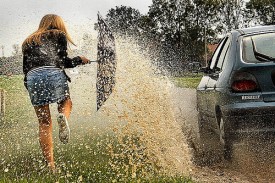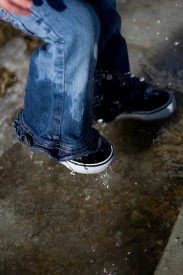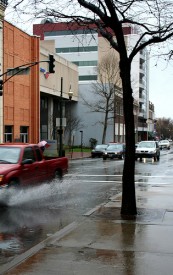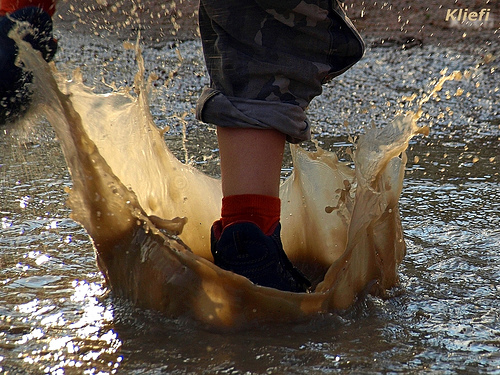Stormwater has been kicking the Northwest’s butt. Armed with back-to-back deluges, the region’s polluted runoff has shown no mercy. For weeks it has soaked us to our socks with deceptively deep and oily puddles. It’s sent icy trickles of rain snaking off awnings and splatting our cheeks and foreheads. It has forced us to leap, not always so nimbly, its muddy mini rapids just to reach the safety of the sidewalk.
People of the waterlogged Northwest, it doesn’t have to be like this. By changing how we build our streets and structures, more of that polluted runoff can be allowed to soak into the ground or get soaked up by the leaves and roots of plants. It can be funneled into large cisterns and saved for a not-so-rainy day.
It’s time to tame the rain. We can help do this by implementing rules that will change how we build our roads, sidewalks, alleys, parking lots, roadside gardens, and rooftops. Right now, Washington’s Department of Ecology is accepting comments on just such rules for reducing and cleaning up these soggy torrents of dirty runoff.
These rules are a big deal not just considering our personal discomfort and hassle, but for the broader landscape and health of our fragile ecosystems for years to come.
“Polluted runoff is our number one urban water quality problem in the state,” said Ecology director Ted Sturdevant in an interview when the rules were released in October.
“This permit is about how do we regulate stormwater, how do we deal with development, how do we grow?” Sturdevant said. “This is going to take us close to 2020.”

The consensus among stormwater experts is that what we’ve been doing — building gutters and settling ponds and pipes that empty into streams — isn’t working. If you’ve navigated the pond-sized puddles, and seen your neighbors stacking sandbags in an effort to keep the rain from turning their basements into a musty mess, you don’t need much convincing.
The question, said Sturdevant, is “how do we continue to develop in ways that doesn’t make (stormwater runoff) worse.”
The answer lies with low-impact development, or LID. Ecology’s proposed rules require more extensive use of these building technologies and strategies to preserve native plants and soils. However, there are critics on both sides of the proposed regulations charging that the rules either don’t go far enough, or that they go too far in mandating the use of rain gardens, green roofs, porous pavement and other low-impact development tools. (See these stories from the Associated Press and KPLU.)
Here’s the struggle. To really truly save local waterways, the rules are going to have to push local cities and counties beyond their comfort zone. Government officials and developers are going to have to install concrete and asphalt that behaves more like a sponge than a rock in places they would not have in the past. They’re going to have to figure out ways to get more green roofs on top of buildings, perhaps learning how from Portland. They’ll have to get more rain gardens in the ground, in yards, and along roadways. Local codes need to be updated with an eye to LID for road construction, tree and plant preservation, and water collection for watering yards and flushing toilets.

But the rules also need a bit of flexibility so that they don’t require the construction of projects that are doomed to fail, ultimately undermining efforts to expand the use of low-impact development. No one wants another Ballard roadside rain gardens on their watch.
And arguably the most important aspect of LID — curbing sprawl and protecting native plants and soils — is admittedly challenging to address through stormwater regulations, but it still needs to be done.
Some of the strengths of the proposed rules include the expansion of the stormwater regulations to cover projects less than 1 acre in size, while the existing rules gave a pass to smaller developments. They require on-the-ground monitoring to measure pollution levels and they mandate the use of many LID technologies that were optional before.
But there are loopholes and “off ramps” in the regulations that allow developers to duck many of the requirements. Green roofs, for example, are required for large commercial buildings — unless the developer can make the case that the ecoroof is too expensive. While economic studies have shown that in the long term the planted roofs are cheaper because they last much longer, the new rule makes it ridiculously easy for a developer to show that it costs more upfront to build an ecoroof compared to a conventional torchdown, which means the rule is essentially ineffective.
And the rules don’t include other low-impact development techniques including rainwater capture in cisterns or the use of “pin pilings,” a type of foundation that preserves the soil around and under a building so that water can soak into and pass through it.

Stronger requirements could provide local businesses a degree of confidence that there would be customers for their LID technologies. They could then perfect and sell LID products and services specifically suited to the Northwest, including porous asphalt, green roofs, water reuse systems, and rain-garden landscaping and maintenance businesses. Stricter rules could nudge city departments and workers who have resisted low-impact development into learning more about it and incorporating it into their projects. Fear of LID and a resistance to change are frequently cited by green-stormwater proponents as top reasons for the slow expansion of these strategies. Stricter rules could help change that.
So just say no more to overflowing ditches that could flush a small dog out to sea, to downspouts spewing water with the force of a fire hose. Ecology is taking comments on the rules until 5 p.m. on Feb. 3, 2012. Wring out your socks, and make yourself heard.


Comments are closed.